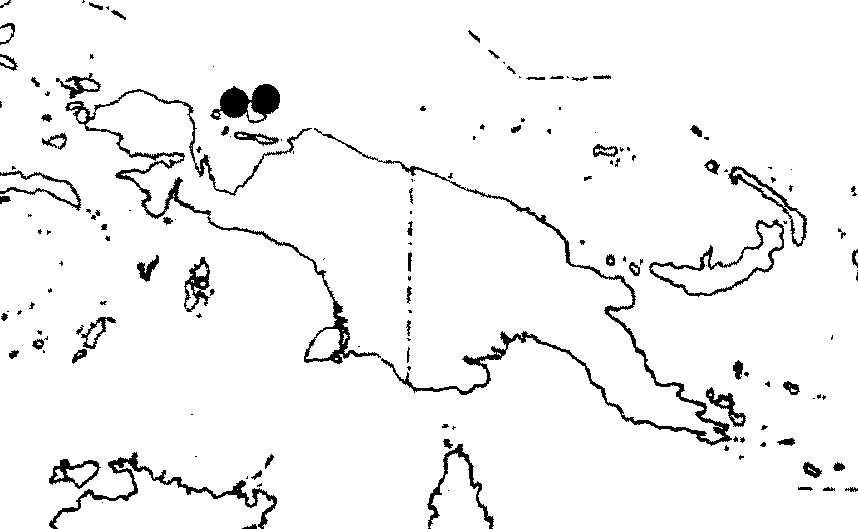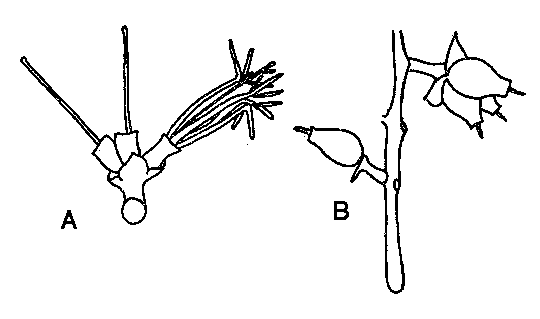
Distribution Map

Description (Barlow 1993)
Decaisnina micranthes (Danser) Barlow
Amylotheca micranthes Danser, Blumea 2 (1936) 34. - Decaisnina micranthes (Danser) Barlow, Austral. J. Bot 22 (1974) 540. - TyPe: de Bruyn 369 (lecto L 957.969-53, see below), New Guinea, Biak, Bosnek, c. 100 m, 2.ix.1915.
For description and synonymy see Barlow, Austral.
J. Bot. 22 (1974) 540. Apart from its very small flowers with
completely choripetalous corollas, D. micranthes has few
specialized characters, and thus presents a relatively generalized
facies for the genus. The species can be identified locally by
its combination of distinctly petiolate, powdery green leaves
dull on both sides, inflorescence axis 35-40 mm long with c. 5
evenly spaced pairs of triads, and very short corolla less than
10 mm long with petals eventually separating completely to the
base. The flower colour has been recorded once, as light green.
Decaisnina micranthes is only known from the island of
Biak, Vogelkop region, western New Guinea (Fig. 4; 4 collections
examined), recorded at low elevations from sea level to 100 m.
Habitat details are poorly known; recorded hosts include Glochidion
and Macaranga.
The species is probably closely related to D. cumingii, which occurs allopatrically in the Moluccas and Philippines, and which also has angular young stems, isofacial leaves, and relatively small flowers. Decaisnina micranthes differs from D. cumingii in its inflorescence with more uniformly spaced triads, much shorter corollas not inflated at the base, and petals separating to the base at anthesis. The species is also possibly related to D. djamuensis (for notes on distinguishing characters and biogeography, see there).
The holotype of Amylotheca micranthes (B) is no longer
extant. An isotype in L has been seen and identified as lectotype
of the species name.
Description (Barlow 1974)
Decaisnina micranthes (Dans.) Barlow, comb. nov.
Amylotheca micranthes Dans. Blumea 2: 34 (1936). Type. Biak, Bosnek, c. 100 m alt., F. de Bruyn 369, 2.ix.1915 (B, holotype, not seen, possibly destroyed; L 95796953).
Glabrous or the young stems sparsely brown-tomentose. Young and mature stems terete. Petiole c. 1 cm long; lamina oblong-lanceolate to elliptical, 6-8 by 2.5-4 cm, dull on both sides, contracted at the base, marginate when young, more or less rounded at the apex hut the larger leaves somewhat acuminate; venation pennate with the midrib distinct and the lateral veins faintly visible on both sides. Inflorescences mostly solitary in the axils; axis usually bearing 5 pairs of triads, 2-3 cm long in flower, elongating in fruit; peduncles of the triads c. 1 mm long but reaching 2 5 mm in fruit; lateral flowers of the triads almost sessile; bracts rounded, spreading, 1 mm long. Calyx cylindrical, 2 mm long; limb irregularly split, 0.3 mm long. Corolla in the mature bud 6-7 mm long; petals in the open flower separating to the base. Anthers 1.5 mm long, longer than the free parts of the filaments. Style articulate 1-1.5 mm above the base leaving a nipple which persists on the fruit. Fruit urceolate, crowned by the persistent calyx limb, 5 mm long. (Fig. 1, b, c.).
Occurrence. Island of Biak, West Irian (Fig. 3).
Specimens Examined. WEST
IRIAN: Biak: Oregontrail, 20 m alt., Vink BW 11500, 29.vi.1961
(LAE; L); Oregontrail, 20 m alt., Vink BW 12009, 29.vi.1961 (LAE).
Illustrations

Decaisnina micranthes. A - triad. B - portion of infructescence. From Barlow (1974).
Decaisnina micranthes
updated 19 January 2007